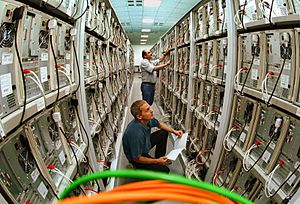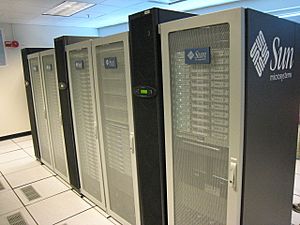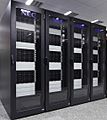Cluster (computing) facts for kids

A computer cluster is like a team of computers that work together. Even though they are separate machines, they act like one big, powerful system. Imagine a group of friends working on a big school project; each friend does a part, but they all contribute to the same goal.
In a computer cluster, each computer (called a node) usually works on the same kind of task. Special software helps them share the work and stay organized. This is different from grid computing, where computers often work on different parts of a much larger problem and can be spread out all over the world. Cluster computers are usually closer together and focus on similar jobs.
People use computer clusters to make things run faster and more reliably than a single computer could. They are also often cheaper than buying one super-fast, super-reliable computer.
Contents
What is a Computer Cluster?
A computer cluster is a group of connected computers that work together. They are linked by fast networks and use special software to act as one system. This setup helps them handle big tasks or lots of users at once.
Why Use Computer Clusters?
Clusters are used for a few main reasons:
- More Power: They can do much more work than a single computer. Think of it like many small engines working together to power a big machine.
- Better Reliability: If one computer in the cluster breaks down, the others can often take over its work. This means the system keeps running smoothly.
- Cost-Effective: It's often cheaper to buy several regular computers and link them together than to buy one extremely powerful, specialized computer.
History of Clusters
The idea of linking computers together isn't new. One of the first systems designed like a cluster was the Burroughs B5700 in the mid-1960s. This system allowed several computers to work together and share storage. If one computer needed to restart, the others could keep working without stopping everything.
Computer clusters became more popular as technology improved. Things like cheaper computer parts, faster internet connections, and special software for sharing tasks between computers all helped clusters grow.
How Clusters are Used Today
Computer clusters are used for many different things, from small businesses to the world's fastest supercomputers.
Everyday Uses
- Web Services: Many big websites use clusters to handle millions of visitors at once. When you visit a popular website, you might be connecting to a computer that's part of a large cluster.
- Databases: Companies use clusters to store and manage huge amounts of information, like customer records or online shopping data.
- Cloud Computing: Services like Google Drive or Netflix often run on massive computer clusters in data centers.
Science and Research
- Scientific Calculations: Scientists use clusters for complex tasks like predicting weather, designing new medicines, or understanding how the universe works.
- Simulations: Engineers use clusters to simulate car crashes, airplane flights, or how new buildings will stand up to earthquakes.
- Artificial Intelligence: Training AI models, especially for things like image recognition or language processing, requires a lot of computing power, often provided by clusters.
Some of the most powerful supercomputers in the world, like IBM's Sequoia, are actually huge computer clusters with thousands of connected machines working together.
Images for kids
-
A NEC Nehalem cluster
-
A pre-release sample of the Ground Electronics/AB Open Circumference C25 cluster computer system, fitted with 8x Raspberry Pi 3 Model B+ and 1x UDOO x86 boards.
See also
 In Spanish: Clúster de computadoras para niños
In Spanish: Clúster de computadoras para niños









